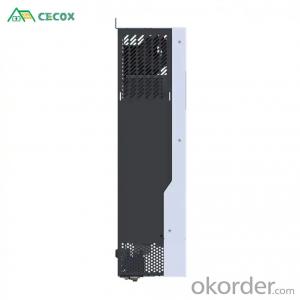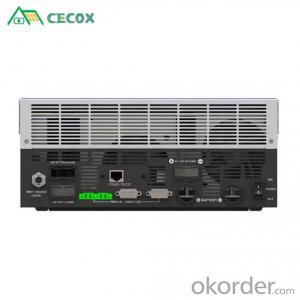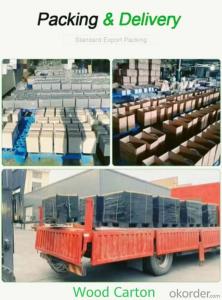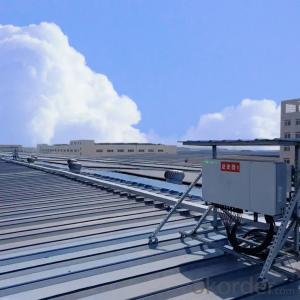5.5KW Off-grid Hybrid Solar Home Inverter With MPPT Charge Controller
- Loading Port:
- China main port
- Payment Terms:
- TT OR LC
- Min Order Qty:
- 1 unit
- Supply Capability:
- 10000 unit/month
OKorder Service Pledge
OKorder Financial Service
You Might Also Like
Item specifice
Advantages
110A PV MPPT input
Wide PV input voltage range
Overload/overtemperature/short circuit protection
Smart battery charger design to optimize battery performance
Support mains/generator input
Adaptive lithium battery
Support maximum parallel machine (P model)
Multiple charging voltages, suitable for different batteries
Multiple working modes: mains priority, PV priority
Key Parameters
Output Type:Single, Pure Sine Wave
Type:DC/AC Inverters
Inverter Efficiency:94%
Place of Origin:China
Model Number:XN5548, XN5548-P
Input Voltage:48V DC
Output Voltage:230V AC ± 5%
Output Current:23A
Output Frequency:50Hz/60Hz
Size:472W*297H*133D mm
Certificate:CE/IEC/ISO/TUV
Warranty:5 years
Weight:10.5kg
5.5KW Off-grid Hybrid Solar Home Inverter WithMPPT Charge Controller
Battery Type:Lithium/Lead-acid
Rated Power:5500W
Waveform:Pure Sine Wave
Transfer Time:10ms
Maximum PV Array Power:6000W
Maximum Solar Charge Current:110A
AC Input Voltage:230V AC
Communication Port:RS232 / RS485
Packaging and delivery
Package Type:Standard Export Package
Supply Ability:10000 Unit/Units per Month
Lead Time
Quantity (units) 1 - 100 101 - 500 501 - 1000 > 1000
Lead time (days) 7 14 21 To be negotiated
Customized packaging:(Min. order) 50000sets
- Q:What is the maximum operating altitude for a solar inverter?
- The maximum operating altitude for a solar inverter can vary depending on the specific model and manufacturer. However, most solar inverters are designed to operate effectively up to an altitude of around 2,000 meters or 6,500 feet above sea level. It is important to consult the manufacturer's specifications for the specific model to determine the exact maximum operating altitude.
- Q:What is the difference between an on-grid and off-grid solar inverter?
- An on-grid solar inverter is designed to convert the DC power generated by solar panels into AC power that can be fed into the electricity grid. It synchronizes the solar power output with the grid's frequency and voltage, ensuring a seamless integration and allowing any excess power to be exported back to the grid. On the other hand, an off-grid solar inverter is used in standalone solar power systems that are not connected to the grid. It converts the DC power from solar panels into AC power for immediate use or storage in batteries. These systems typically require additional components like batteries and charge controllers to manage power storage and supply during periods of low solar generation or high demand. In summary, the main difference between the two types of inverters is their purpose: on-grid inverters are used for grid-tied systems, while off-grid inverters are used in standalone systems not connected to the grid.
- Q:Can a solar inverter be installed in a multi-storey building?
- Yes, a solar inverter can be installed in a multi-storey building. The installation of a solar inverter in a multi-storey building is possible and depends on various factors such as the availability of suitable roof space, electrical infrastructure, and compliance with local regulations. It is essential to consult with a professional solar installer to assess the feasibility and design a tailored solar energy system for the specific building.
- Q:What is the maximum power rating of a solar inverter?
- The maximum power rating of a solar inverter can vary depending on the specific model and manufacturer. However, typical residential solar inverters have power ratings ranging from 1,000 to 10,000 watts, while commercial and utility-scale inverters can have ratings exceeding several hundred kilowatts or even megawatts.
- Q:What maintenance is required for a solar inverter?
- Regular maintenance for a solar inverter typically includes visual inspection for dust or dirt accumulation, checking for loose connections, monitoring the inverter's performance, and ensuring proper ventilation. Additionally, it is recommended to clean the solar panels periodically to maximize the system's efficiency.
- Q:What is the role of a solar inverter in preventing system failures?
- The role of a solar inverter in preventing system failures is to convert the direct current (DC) produced by solar panels into alternating current (AC) that can be used by household appliances and sent back to the electrical grid. By ensuring that the DC power generated by the solar panels is properly converted and synchronized with the grid, the inverter helps maintain the stability and reliability of the entire solar power system. Additionally, the inverter monitors the voltage, frequency, and overall performance of the system, allowing it to detect and respond to any potential issues or faults that could lead to system failures.
- Q:Are there any government regulations or certifications for solar inverters?
- Yes, there are government regulations and certifications for solar inverters. These regulations vary by country and region, but typically involve safety standards, grid compatibility requirements, and product testing procedures. Additionally, various certifications such as UL, IEC, and CE are commonly required to ensure the quality and reliability of solar inverters in the market.
- Q:How does a solar inverter handle voltage and frequency variations caused by switching operations?
- A solar inverter is designed to handle voltage and frequency variations caused by switching operations through its built-in control mechanisms and advanced technology. When a solar inverter is connected to the grid, it monitors the voltage and frequency of the grid and adjusts its operation accordingly to maintain stability and safety. In the case of voltage variations caused by switching operations, a solar inverter typically employs a voltage control mechanism. This mechanism continuously monitors the voltage level of the grid and adjusts the output voltage of the inverter to match the grid voltage. If the grid voltage rises or falls beyond a certain threshold, the inverter automatically adjusts its output voltage to compensate and maintain a stable voltage level. Similarly, for frequency variations caused by switching operations, a solar inverter utilizes a frequency control mechanism. This mechanism constantly monitors the grid frequency and adjusts the inverter's output frequency to match the grid frequency. If the grid frequency deviates from the standard frequency, the inverter can quickly respond by adjusting its output frequency to maintain synchronization with the grid. To achieve this level of control, solar inverters often incorporate advanced digital signal processing algorithms and sophisticated control systems. These algorithms and control systems analyze the voltage and frequency signals from the grid, and based on predefined parameters, make rapid adjustments to the inverter's output to ensure compatibility with the grid. Ultimately, the goal of a solar inverter is to seamlessly integrate with the grid and provide a stable, reliable, and efficient power supply. By effectively handling voltage and frequency variations caused by switching operations, the inverter contributes to the overall stability and resilience of the grid, allowing for optimal utilization of solar energy and promoting a sustainable energy future.
- Q:Can a solar inverter be used with different types of energy storage systems?
- Yes, a solar inverter can be used with different types of energy storage systems. Solar inverters are designed to convert the direct current (DC) generated by solar panels into alternating current (AC) that can be used to power electrical devices. The AC output from the solar inverter can be connected to various energy storage systems, such as batteries, to store excess energy generated by the solar panels for later use. Therefore, solar inverters are compatible with different types of energy storage systems, allowing for efficient utilization of solar energy.
- Q:How efficient are solar inverters?
- Solar inverters are highly efficient, with most modern models achieving efficiency levels of 95% or higher. This means that they can convert a significant amount of the DC power generated by solar panels into usable AC power for homes and businesses, minimizing energy losses and maximizing the overall efficiency of the solar system.
1. Manufacturer Overview |
|
|---|---|
| Location | |
| Year Established | |
| Annual Output Value | |
| Main Markets | |
| Company Certifications | |
2. Manufacturer Certificates |
|
|---|---|
| a) Certification Name | |
| Range | |
| Reference | |
| Validity Period | |
3. Manufacturer Capability |
|
|---|---|
| a)Trade Capacity | |
| Nearest Port | |
| Export Percentage | |
| No.of Employees in Trade Department | |
| Language Spoken: | |
| b)Factory Information | |
| Factory Size: | |
| No. of Production Lines | |
| Contract Manufacturing | |
| Product Price Range | |
Send your message to us
5.5KW Off-grid Hybrid Solar Home Inverter With MPPT Charge Controller
- Loading Port:
- China main port
- Payment Terms:
- TT OR LC
- Min Order Qty:
- 1 unit
- Supply Capability:
- 10000 unit/month
OKorder Service Pledge
OKorder Financial Service
Similar products
New products
Hot products
Hot Searches
Related keywords
































